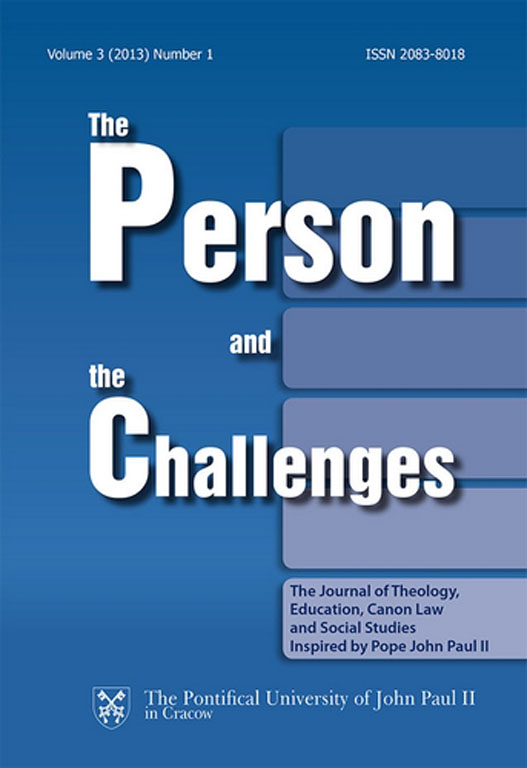Understanding the Changing Landscape of Contemporary Spirituality.: A useful starting point for reviewing Catholic school religious education
DOI:
https://doi.org/10.15633/pch.480Słowa kluczowe:
Changes in spirituality, cultural meanings, secularisation, Catholic schools, religious educationAbstrakt
Pope John Paul II, following in the steps of his predecessors, strongly advocated the critical appraisal of the influence of culture on people’s spirituality. This article responds to his directive by seeking to develop an interpretation of how and why contemporary spirituality has changed that will better inform the work of religious educators in Catholic schools. A number of constructs like secularisation, privatisation of religion etc. have been used to describe the significant change in spirituality of many of the young people in Australian Catholic schools over the last 50 years from a more traditional religious spirituality to something that is more secular, eclectic and individualistic. To some extent, this change has been acknowledged; but the religion curricula in Catholic schools still give the impression that all of the students are, or should be, regular church goers – as if Sunday mass attendance was to be the end point of their education in spirituality. An interpretation of change in spirituality in terms of change in cultural meanings has been developed for the purpose of understanding contemporary spiritualities in other than a deficit model. Such an interpretation may be more persuasive in getting Catholic education authorities and religious educators firstly to accept, rather than condemn or ignore, the significant change in contemporary spiritualty; and then secondly, to take steps to address this change positively and constructively in the Catholic school religion curriculum. This article is concerned with the first step – understanding contemporary spirituality; it is intended that the second question will be considered in a follow up article.Bibliografia
Boeve L., Religion after detraditionalization: Christian faith in a post-secular Europe, „Irish Theological Quarterly”,70 (2005) 2, p. 99–122.
Boeve L., Communicating faith in contemporary Europe: Dealing with language problems In and Outside the Church, In J. Sullivan (Ed.) Communicating faith. Washington 2011. Catholic University of America Press.
Crawford M., Rossiter G., Missionaries to a teenage culture: Religious education in a time of rapid change. Sydney 1988. Christian Brothers Province Resource Group.
Crawford M., Rossiter G., Reasons for living: Education and young people’s search for meaning, identity and spirituality. Melbourne 2006. Australian Council for Educational Research.
Eckersley R., Well and good: Morality, meaning and happiness. Melbourne 2005. Text Publishing.
Eckersley R., Wierenga A., Wyn J., Flashpoints and signposts: Pathways to success and wellbeing for Australia’s young people. Canberra 2006. Australia 21 and the Australian Youth Research Centre.
Francis L.J., Robbins M., Urban hope and spiritual health : The adolescent voice. Peterborough, UK 2005. Epworth.
Hughes P., Putting life together: Findings from Australian youth spirituality research. Fairfield, VIC 2007. Fairfield Press.
Mason M., Singleton A., Webber R., The spirit of Generation Y: Young people’s spirituality in a changing Australia. Melbourne 2007. John Garratt.
Pope John Paul II, Homily, University of Laval Stadium Quebec City, Canadian Catholic Review, 1984, October, 323–325.
Schweitzer F., The postmodern life cycle: Challenges for church and theology. St Louis MI 2004. Chalice.
Schweitzer F., Religious individualization: New challenges to education for tolerance. British Journal of Religious Education. 2007 29(1) 89–100.
Smith C., Denton M.L., Soul searching: The religious and spiritual lives of American teenagers. Oxford 2005. Oxford University Press.
Sullivan J. (Ed.), Communicating faith. Washington 2011. Catholic University of America Press.
Warren M., Communications and cultural analysis: A religious view. Westport, Conn 1992, Bergin & Garvey.
Pobrania
Opublikowane
Numer
Dział
Licencja
Prawa autorskie (c) 2013 Graham Rossiter

Utwór dostępny jest na licencji Creative Commons Uznanie autorstwa 4.0 Międzynarodowe.
Autorzy publikujący w czasopiśmie udzielają jego wydawcy zgody o następującej treści:
- Autor zachowuje autorskie prawa majątkowe do utworu, a jednocześnie udziela wydawcy czasopisma zgody na jego pierwszą publikację w wersji drukowanej i wersji online na licencji Creative Commons Uznanie autorstwa 4.0 Międzynarodowe oraz zgody na wykonywanie opracowań, w tym przekładów.
- Autor ma możliwość udzielania zgody niewyłącznej na opublikowanie utworu w wersji, która ukazała się w czasopiśmie (np. zamieszczenia go w repozytorium instytucjonalnym lub opublikowania w książce), wraz z informacją o jego pierwszej publikacji w czasopiśmie.
- Autor może umieścić swój utwór online (np. w repozytorium instytucjonalnym lub na swojej stronie internetowej) jeszcze przed zgłoszeniem utworu do czasopisma.

